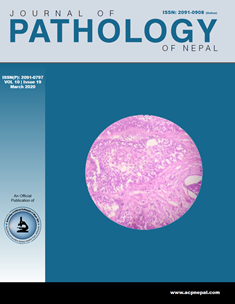Prevalence of subtypes of gastric intestinal metaplasia and its relationship with Helicobacter pylori infection
DOI:
https://doi.org/10.3126/jpn.v10i1.28541Keywords:
Endoscopic biopsy, Gastric intestinal metaplasia, Helicobactor pyloriAbstract
Background: Gastric intestinal metaplasia is seen chronic gastritis associated with Helicobacter pylori. The objective of this study was to determine the prevalence of subtypes of intestinal metaplasia and presence of Helicobacter pylori infection.
Materials and Methods: This was a cross sectional study done at Kathmandu Medical College teaching Hospital in Pathology department from December 2018 to August 2019. The endoscopic biopsies were evaluated for intestinal metaplasia and Helicobacter pylori with the help of Hematoxylin and Eosin stains as well as Giemsa stain. Subtypes of intestinal metaplasia were classified with the help of periodic acid- Schiff/Alcian Blue stain combination and High Iron Diamine- Alcian Blue stain at pH 2.5. The relationship between Helicobacter pylori and subtypes of intestinal metaplasia were compared. Fisher’s exact test was used for statistical evaluation. A p value of ˂0.05 was considered as statistically significant.
Results: The prevalence of intestinal metaplasia was found in 57 (12.2%) biopsies. Type I intestinal metaplasia was found in 23 (40.4%) biopsies, type II in 10 (17.5%) biopsies and type III in 24 (42.1%) biopsies. Helicobacter pylori was positive in 28(49.1%) and it was negative in 29(50.9%) biopsies. No statistical significant correlation was seen in the subtypes of intestinal metaplasia with Helicobacter pylori status (p˃0.05).
Conclusion: Intestinal metaplasia is frequently observed in endoscopic biopsies, most common being type III subtype.
Downloads
Downloads
Published
How to Cite
Issue
Section
License
This license enables reusers to distribute, remix, adapt, and build upon the material in any medium or format, so long as attribution is given to the creator. The license allows for commercial use.




